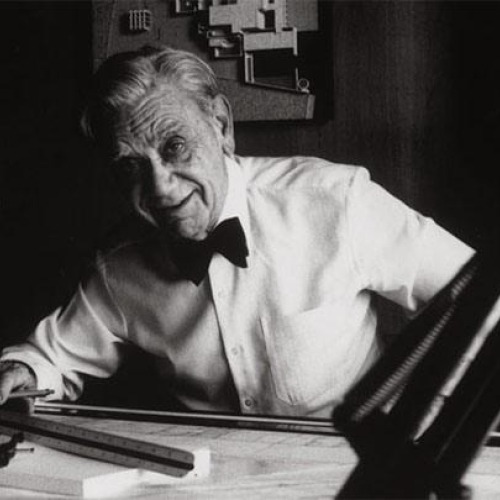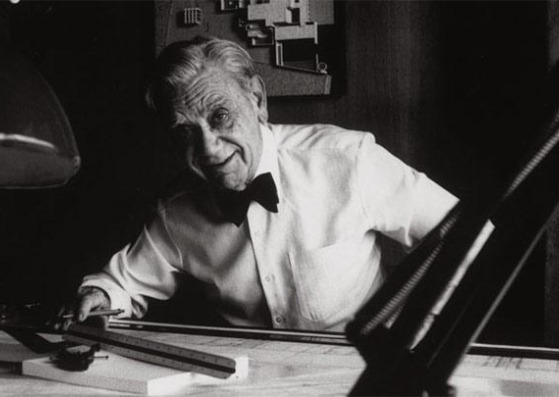Carvajal
Francisco Javier Carvajal Ferrer (January 3, 1926, Barcelona - June 14, 2013, Madrid). He obtained the title of architect in 1953 from the Madrid School of Architecture, being the Extraordinary End of Degree Award; that same year he was Deputy Curator of Architecture and General Deputy Curator of Education at the II Bienal de Arte de Sao-Paulo, Brazil. In 1955 he was a pensioner from the Academy of Fine Arts in Rome where he lived until 1957, the year in which he won the Academy Award of Rome and received the title of Master Academic Honoris Causa from the Academia Mondiale Degli Artisti e Profesionisti di Roma.
In 1959, in collaboration with Javier García de Castro, the Barcelona School of High Mercantile Studies (today the School of Industrial Engineers) won the competition, inaugurated in 1961. This work, next to the residential building in the Plaza de Cristo Rey in Madrid (1954-58), will be one of his best known early works, in them characteristic features of his work are seen, with some invariants that will remain throughout his career.
In 1963 he was awarded first prize in the competition for the Spanish pavilion at the New York World's Fair. Completed in 1964, it was an Award from the Rockefeller Foundation, obtained great international recognition and the Institute of American Architects awarded it a certificate of excellence for the project. From this work he began his work with prefabricated elements on the façade. In 1968, the Technical University of Hannover awarded him the “Fritz Schumacher” prize for the best architectural work built in Europe, for the houses he designed and built in Somosaguas. During the 1960s he was responsible for creating the new aesthetics of Loewe stores.
Also noteworthy are works such as the apartments on Calle Montesquinza, from 1966. In 1968, he built a residential and office building in León, a test of what would later become the Torre de Valencia (1968-1973), the Library of the Faculty of Law de Madrid (1971). In 1972 he created the Madrid Zoo-Aquarium, which has sculptures by José Luis Sánchez and Josep María Subirachy, in 1974, the House of Sweden, in Chile (1976), shortly before the Adriatic in the Paseo de la Castellana in Madrid, the Banco Industrial de León building on Calle Serrano. From his last stage remember the houses of Pozuelo and de la Moraleja, the Embassy of Spain in Warsaw, the palaces of Tabuk and Gassim (1982-1984) in Saudi Arabia, a hotel for the Universal Exposition of Seville in 1992, and finally its last work: the General Library of the University of Navarra (1998).
His teaching work began in 1954 as an assistant professor at the Madrid School of Architecture. In 1960, after his stay in Rome, he was appointed professor in charge of the chair; two years later, in 1962, he obtained a doctorate. And in 1965 he won the chair, becoming the first professor at the Madrid School to achieve it by building modern architecture; in 1967 he was appointed Deputy Director of the School, in 1968 extraordinary professor at the Menéndez Pelayo International University of Santander and in 1971 ordinary professor of Urban Planning courses at the Institute of Local Administration of Madrid. In 1972 he was appointed Director of the School of Barcelona, being the following year founder of the second Higher Technical School of Architecture at the University of Vallés in this city. In 1974 he became Director of the ETSA of Las Palmas de Gran Canaria and in 1976 Professor of Projects at the School of Architecture of the University of Navarra, of which he was also since 1982 extraordinary professor of History of Architecture. In 1997 he was appointed Professor Emeritus of the Madrid School of Architecture.
This teaching work also made her compatible with various positions; thus, in 1971 he would be appointed Dean of the Madrid College of Architects and re-elected in 1973, the year in which he was also appointed Delegate Commissioner of the Ministry of Education and Science, for the Reform of Architecture Education in Spain. In 1964 he became a member of the Editorial Board of the magazine Arquitectura, of the College of Architects of Madrid. In 1965 he was appointed Commissioner of Spain at the IV International Art Biennale in Paris and in 1966 representative of the Official College of Architects of Madrid on the Board of Trustees of the School of Architecture of the Polytechnic University of Madrid and Secretary of the Teaching Commission of the Council Superior of the Colleges of Architects of Spain. In 1971 he acted as Consultant Architect for the implementation of the Architecture Degree in Costa Rica, in 1972 he was appointed by the Ministry of Education and Science as Delegate Commissioner for the reform of Architecture education and the following year General Director of Tourism Planning. In 1994 he was Director of the Cultural Foundation of COAM.
They also stand out as the apartments on calle Montesquinza, from 1966. In 1968, he built a residential and office building in León, a test of what would later become the Torre de Valencia, and in 1974, shortly before the Adriatica on the Paseo de la Castellana de Madrid, the building of the Banco Industrial de León on Serrano Street. From his last stage remember the houses of Pozuelo and de la Moraleja, the Embassy of Spain in Warsaw, a hotel for the Universal Exhibition of Seville in 1992, and finally his last work: the General Library of the University of Navarra.
In 1959, in collaboration with Javier García de Castro, the Barcelona School of High Mercantile Studies (today the School of Industrial Engineers) won the competition, inaugurated in 1961. This work, next to the residential building in the Plaza de Cristo Rey in Madrid (1954-58), will be one of his best known early works, in them characteristic features of his work are seen, with some invariants that will remain throughout his career.
In 1963 he was awarded first prize in the competition for the Spanish pavilion at the New York World's Fair. Completed in 1964, it was an Award from the Rockefeller Foundation, obtained great international recognition and the Institute of American Architects awarded it a certificate of excellence for the project. From this work he began his work with prefabricated elements on the façade. In 1968, the Technical University of Hannover awarded him the “Fritz Schumacher” prize for the best architectural work built in Europe, for the houses he designed and built in Somosaguas. During the 1960s he was responsible for creating the new aesthetics of Loewe stores.
Also noteworthy are works such as the apartments on Calle Montesquinza, from 1966. In 1968, he built a residential and office building in León, a test of what would later become the Torre de Valencia (1968-1973), the Library of the Faculty of Law de Madrid (1971). In 1972 he created the Madrid Zoo-Aquarium, which has sculptures by José Luis Sánchez and Josep María Subirachy, in 1974, the House of Sweden, in Chile (1976), shortly before the Adriatic in the Paseo de la Castellana in Madrid, the Banco Industrial de León building on Calle Serrano. From his last stage remember the houses of Pozuelo and de la Moraleja, the Embassy of Spain in Warsaw, the palaces of Tabuk and Gassim (1982-1984) in Saudi Arabia, a hotel for the Universal Exposition of Seville in 1992, and finally its last work: the General Library of the University of Navarra (1998).
His teaching work began in 1954 as an assistant professor at the Madrid School of Architecture. In 1960, after his stay in Rome, he was appointed professor in charge of the chair; two years later, in 1962, he obtained a doctorate. And in 1965 he won the chair, becoming the first professor at the Madrid School to achieve it by building modern architecture; in 1967 he was appointed Deputy Director of the School, in 1968 extraordinary professor at the Menéndez Pelayo International University of Santander and in 1971 ordinary professor of Urban Planning courses at the Institute of Local Administration of Madrid. In 1972 he was appointed Director of the School of Barcelona, being the following year founder of the second Higher Technical School of Architecture at the University of Vallés in this city. In 1974 he became Director of the ETSA of Las Palmas de Gran Canaria and in 1976 Professor of Projects at the School of Architecture of the University of Navarra, of which he was also since 1982 extraordinary professor of History of Architecture. In 1997 he was appointed Professor Emeritus of the Madrid School of Architecture.
This teaching work also made her compatible with various positions; thus, in 1971 he would be appointed Dean of the Madrid College of Architects and re-elected in 1973, the year in which he was also appointed Delegate Commissioner of the Ministry of Education and Science, for the Reform of Architecture Education in Spain. In 1964 he became a member of the Editorial Board of the magazine Arquitectura, of the College of Architects of Madrid. In 1965 he was appointed Commissioner of Spain at the IV International Art Biennale in Paris and in 1966 representative of the Official College of Architects of Madrid on the Board of Trustees of the School of Architecture of the Polytechnic University of Madrid and Secretary of the Teaching Commission of the Council Superior of the Colleges of Architects of Spain. In 1971 he acted as Consultant Architect for the implementation of the Architecture Degree in Costa Rica, in 1972 he was appointed by the Ministry of Education and Science as Delegate Commissioner for the reform of Architecture education and the following year General Director of Tourism Planning. In 1994 he was Director of the Cultural Foundation of COAM.
They also stand out as the apartments on calle Montesquinza, from 1966. In 1968, he built a residential and office building in León, a test of what would later become the Torre de Valencia, and in 1974, shortly before the Adriatica on the Paseo de la Castellana de Madrid, the building of the Banco Industrial de León on Serrano Street. From his last stage remember the houses of Pozuelo and de la Moraleja, the Embassy of Spain in Warsaw, a hotel for the Universal Exhibition of Seville in 1992, and finally his last work: the General Library of the University of Navarra.
+
-
-
NameFrancisco Javier Carvajal










